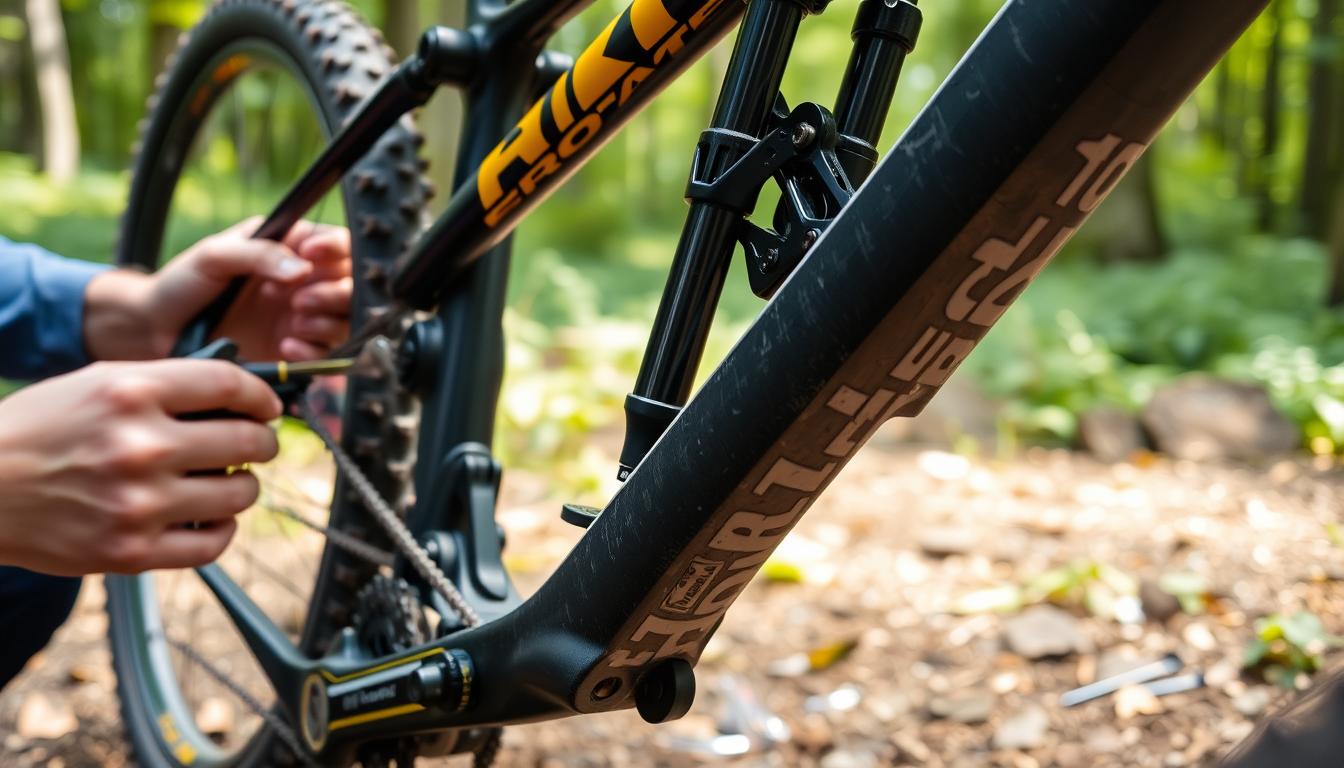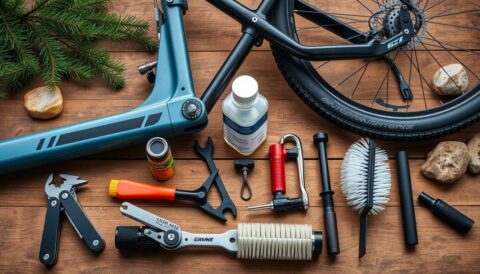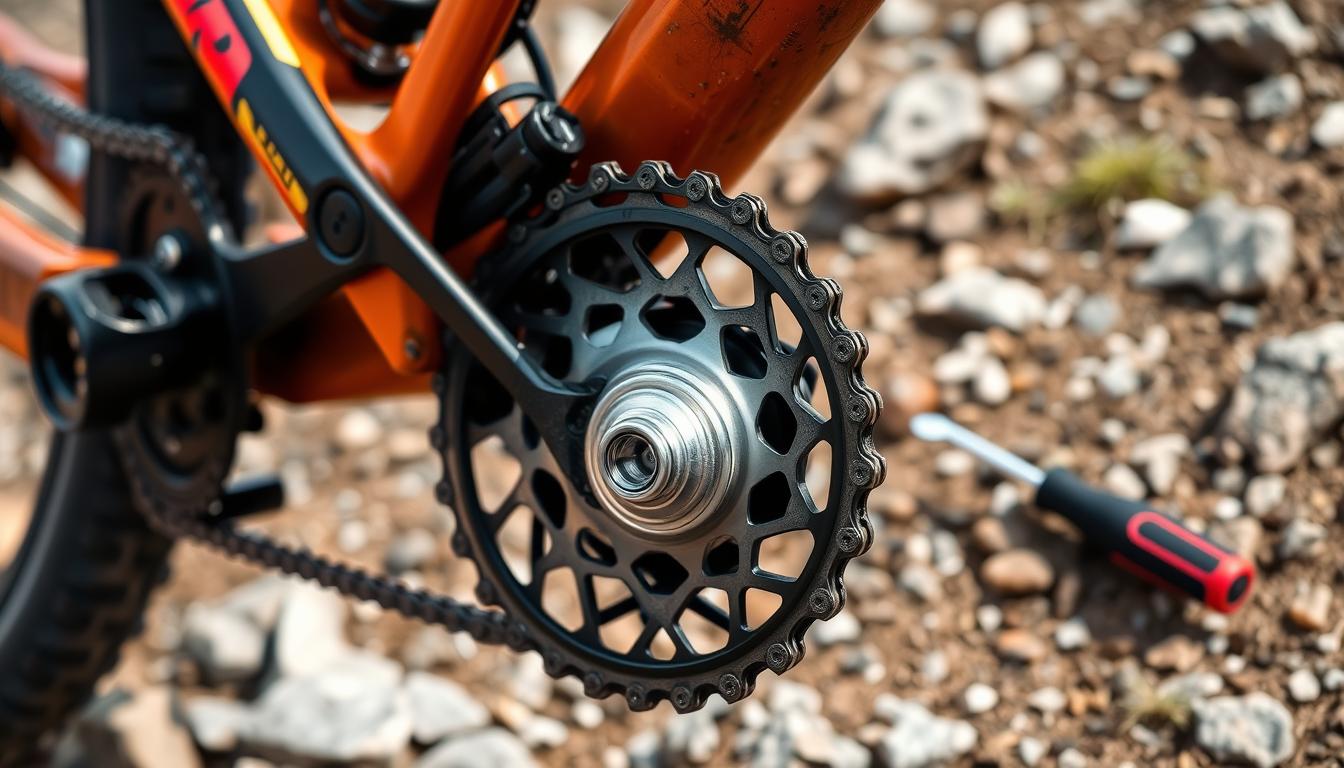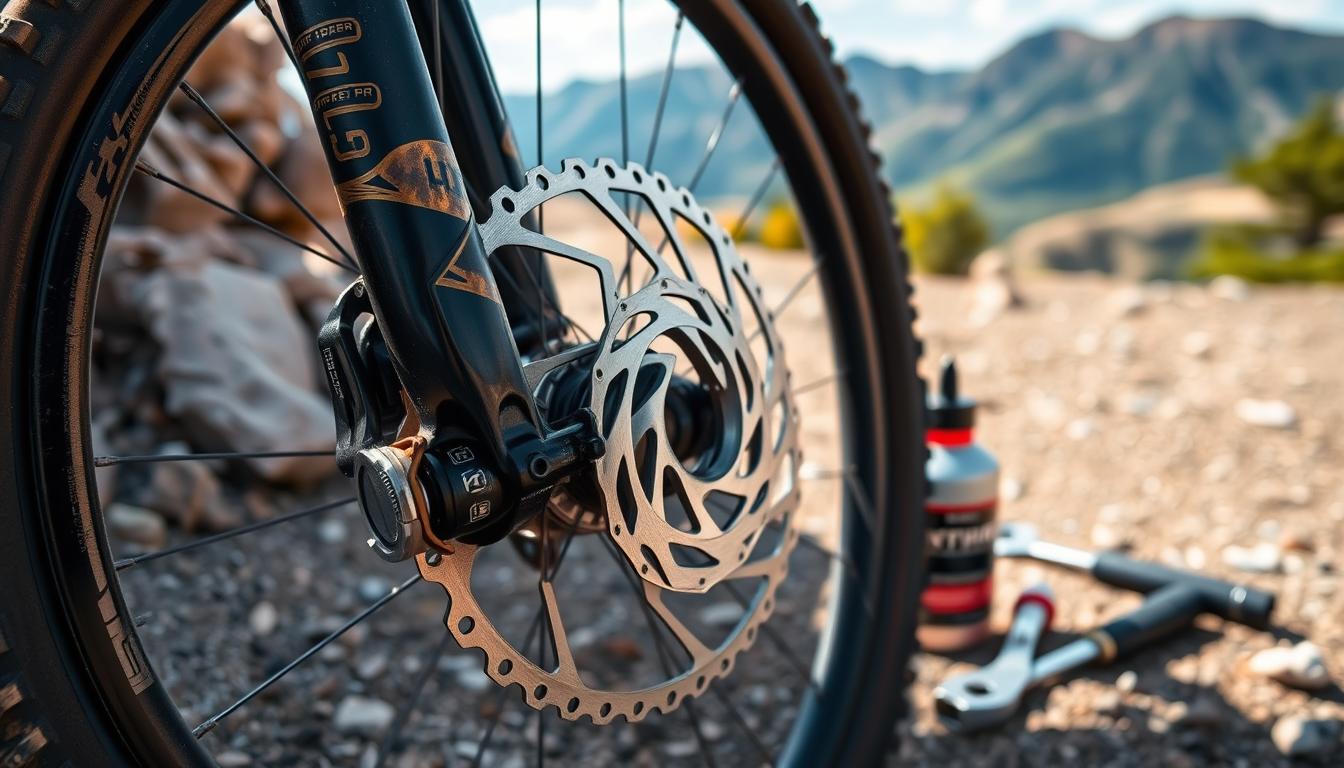Mountain bike suspension is vital for your riding experience. Proper care ensures smooth performance and extends component life. It also keeps your rides comfortable and safe.
Understanding suspension maintenance can transform your cycling adventures. Fox and RockShox recommend regular fork service to keep suspensions in top shape. Fox suggests service every 125 hours, while RockShox advises more frequent check-ups.
Mountain bike suspension involves complex components that need careful attention. Dirt, moisture, and regular riding can cause wear. Consistent bike maintenance is crucial to prevent issues.
Simple practices like wiping down stanchions and checking air pressure can prevent costly damage. These steps also help avoid performance problems.
Riders should develop a routine for suspension care. This includes regular cleaning, lubrication, and performance monitoring. Investing time in fork and shock maintenance ensures a smoother ride on various terrains.
Understanding Mountain Bike Suspension Components
Mountain bike suspension absorbs terrain impacts and improves control. It’s a complex system that enhances your riding experience. Knowing your suspension fork and rear shock components helps maintain performance and longevity.
Front Fork Components and Their Functions
Suspension forks are more than simple shock absorbers. They have several critical parts working together for smooth riding.
- Stanchions: The upper tubes that slide through seals
- Air piston: Controls suspension compression and travel
- Damper: Regulates the speed of suspension movement
- Seals: Prevent dirt and moisture from entering internal mechanisms
Air forks offer incredible adjustability, making them popular among cross-country riders seeking efficiency and climbing performance.
Rear Shock Basics and Operation
Rear shocks are crucial in full-suspension mountain bikes. They connect the frame’s front and rear triangles. Modern rear shocks have sophisticated designs for fine-tuning suspension characteristics.
Common Wear Points and Problem Areas
Suspension components face significant stress during rides. Regular inspection is needed for key areas.
- Stanchion surfaces
- Seals and wipers
- Air pistons
- Damper internals
Regular maintenance can prevent costly replacements and ensure optimal suspension performance. FOX recommends a complete suspension overhaul every 125 riding hours or annually. This helps protect your investment and ensures smoother rides.
Signs Your Suspension Needs Attention
Mountain bikers must keep an eye on their suspension system. Ignoring problems can ruin your ride and cause costly damage. Regular checks are essential for a smooth cycling experience.
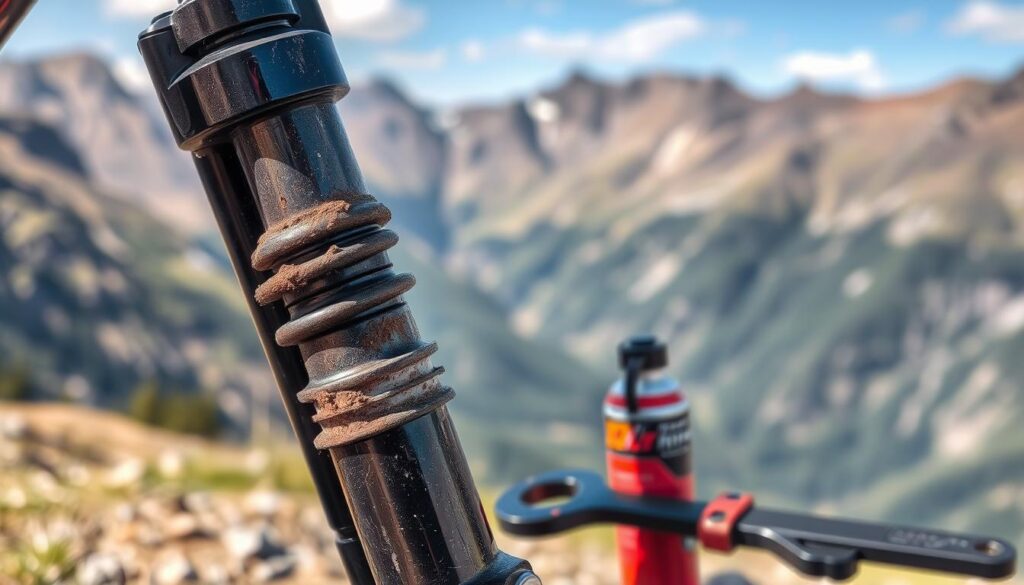
- Unusual creaking or grinding noises during rides
- Reduced small bump sensitivity
- Visibly worn stanchion coatings
- Stiff or unresponsive fork movement
Performance issues often sneak up on you. A thorough fork service is crucial when you spot these warning signs. Dirt, water, and wear can harm your shock maintenance.
“Prevention is always cheaper than replacement” – Mountain Bike Maintenance Experts
Your suspension’s response affects your ride quality. Watch for reduced rear shock action, oil leaks, or air pressure issues. These signs mean you need a professional check-up.
Good handling and upkeep can make your suspension last longer. It also ensures you get the best performance on the trails.
Mountain Bike Suspension Maintenance Essentials
Proper suspension care is vital for your mountain bike’s performance. It extends the life of crucial components and ensures smooth rides. Regular upkeep is key for professional cyclists and seasoned riders alike.
Essential maintenance practices help preserve your bike’s suspension system. These techniques ensure smooth riding across various terrains. Let’s explore the key aspects of suspension care.
Cleaning and Lubrication Techniques
Gentle cleaning is crucial for suspension maintenance. Use mild soap and soft cloths to clean stanchions and shock absorbers. Avoid high-pressure washing as it can harm delicate seals.
- Use specific fork lubrication products designed for mountain bike suspensions
- Clean stanchions after every challenging ride
- Apply thin layers of suspension-specific lubricant
- Wipe down components thoroughly to prevent dirt accumulation
Proper Air Pressure Management
Correct air pressure is crucial for suspension performance. It affects control and component wear. Regular checks help maintain optimal pressure levels.
- Check air pressure every two months
- Use a reliable pressure gauge
- Adjust according to rider weight and terrain
- Consult manufacturer recommendations for specific settings
Seal and Wiper Care
Seal maintenance keeps dirt and moisture out of your suspension. This preserves its functionality and longevity. Check seals and wipers often for wear or damage.
“Prevention is always better than costly repairs when it comes to mountain bike suspension”
Following these maintenance tips keeps your mountain bike suspension in top shape. It ensures smooth and reliable performance across diverse riding conditions. Your bike will thank you with many great rides ahead.
Professional Service Intervals and DIY Maintenance
Regular maintenance of your mountain bike’s suspension is vital. It ensures top performance and extends component life. Balancing DIY upkeep with professional servicing is key.
Service intervals depend on your riding habits. The guide below will help keep your suspension in prime condition:
- Frequent riders: Professional servicing every 3-4 months or 50 hours of riding
- Casual riders: Annual professional servicing or every 125 hours
DIY maintenance is crucial for suspension care. Regular checks prevent costly repairs and ensure smooth rides.
- Clean suspension components after each ride
- Check air pressure before rides
- Inspect seals and wipers for damage
- Lubricate moving parts
*Pro tip: Track your ride time using cycling apps to monitor service intervals accurately*
Basic maintenance can be done at home. However, complex tasks need professional expertise. Specialised tools and technical knowledge are essential for thorough suspension servicing.
Brands like RockShox and Fox recommend professional care at specific times. This helps maintain peak performance. Regular servicing and DIY upkeep will save money and boost your biking experience.
Conclusion
Effective suspension care is vital for an exceptional riding experience. Regular maintenance can boost bike performance and prevent costly replacements. Following manufacturer recommendations from Fox, RockShox, and Ohlins can extend your suspension’s lifespan.
Regular inspection and cleaning can save hundreds of pounds in potential repair costs. Check air pressure, lubricate stanchions, and monitor wear indicators during every ride. These steps help maintain traction, control, and comfort on challenging terrains.
Your mountain bike’s suspension is a significant investment. Systematic maintenance ensures smoother, more controlled rides and reduces unexpected breakdowns. Understanding your suspension’s needs and following service intervals maximises performance and enjoyment.
Consistent care is key to exceptional riding. Prioritising suspension maintenance will elevate your cycling experience. It also protects your valuable equipment, regardless of your riding frequency or skill level.
FAQ
How often should I service my mountain bike suspension?
Service intervals vary based on riding frequency and conditions. RockShox suggests a full service every 200 hours. Fox recommends servicing after 125 hours of use.
Regular riders should service their bikes before reaching these limits. Basic maintenance, like cleaning and lubrication, should be done more often.
What are the signs that my mountain bike suspension needs maintenance?
Watch out for strange creaking sounds and a harsh ride feel. Loss of small bump sensitivity is another sign to look for.
Check for visible wear on stanchion coatings and dry or stiff fork movement. Reduced rear shock action and noticeable oil or air loss are also red flags.
Can I perform suspension maintenance myself?
You can do basic tasks like cleaning with mild soap and lubricating stanchions. Checking air pressure and inspecting seals are also manageable for most riders.
Full rebuilds and damper services need professional skills and special tools. Use apps like Strava to track your ride time and service intervals.
What components should I pay special attention to during suspension maintenance?
Focus on dust wipers, foam rings, seals, bushings, and stanchion coatings. Regular checks of these parts help prevent early wear and tear.
Use suspension-specific oil to lubricate foam rings. Keep stanchions clean and well-lubricated for best performance.
How should I clean my mountain bike suspension?
Use mild soap and water to clean your suspension. Avoid high-pressure washing near seals to prevent damage.
Gently clean dust wipers and foam rings. Use fork oil or suspension lubricant on stanchions. Follow the maker’s guidelines to avoid damaging parts.
What’s the difference between air and coil suspension?
Air suspension uses an adjustable air chamber for tuning. It’s lighter and easier to customise.
Coil suspension uses a metal spring. It offers more consistent performance and better small bump sensitivity. Choose based on your riding style.
How important is proper suspension maintenance?
Proper maintenance is crucial for your bike’s suspension. It prevents early wear and keeps performance at its best.
Regular care improves riding comfort and protects your investment. Well-maintained suspension ensures better bike performance and a safer, more enjoyable ride.
